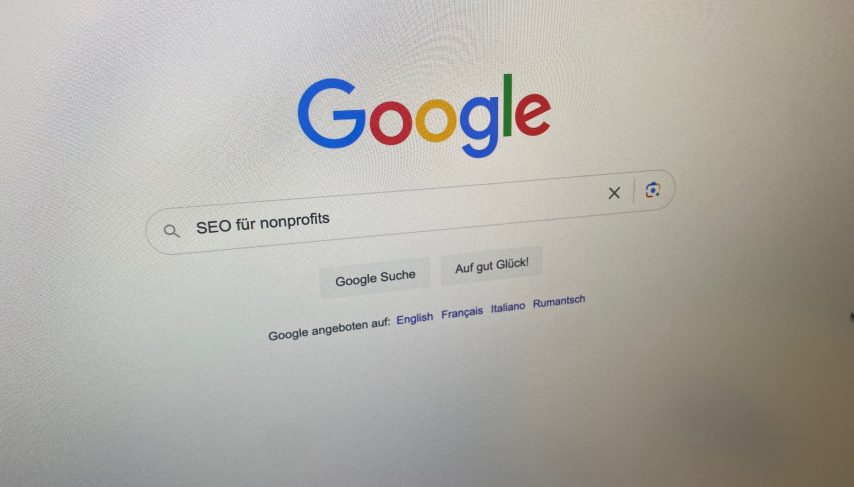
Table of contents:
1. what is SEO & why is it important for NGOs & associations?
2. what is the difference between SEO&SEA for nonprofits?
3. how do you measure SEO success for non-profit organizations?
4. keyword research: SEO keywords for non-profit organizations
5. regularly create relevant SEO content for the non-profit organization
6. technical SEO for nonprofits – optimization for users & Googlebot
7. local SEO & Google My Business profile for NGOs
8. achieve more visibility & reach for your nonprofit organization with SEO
9. search engine optimization for your nonprofit organization
What is SEO & why is it important for NGOs & associations?
Someone in Switzerland searches for the keyword “donate” on Google around 1,300 times a month. The first three search results that appear receive over 35 percent of all clicks. In this case, these are foundations, associations and charitable organizations that collect donations. Thanks to their excellent position on Google, they have a particularly good chance of receiving a donation from these 1,300 people. However, this placement is neither luck nor coincidence, the websites are search engine optimized.
How do you get started with SEO for a non-profit organization, which strategies are most effective for NGOs, which tools are recommended? We have summarized what you absolutely need to know about SEO for non-profit organizations and five tips for SEO newcomers.
What is the difference between SEO & SEA for nonprofits?
SEO and SEA, two abbreviations that are not only superficially similar, but also have a lot in common. SEO stands for Search Engine Optimization. SEA stands for Search Engine Advertising, i.e. (paid) search engine advertising. SEO refers to the organic rankings, i.e. the position that Google gives a website based on its relevance for the respective search query. SEA, on the other hand, is responsible for the entries at the top of the search results.
Up to four entries above the search results are labeled “Sponsored” as paid search engine advertising. There are up to three SEA entries after the first ten organic search results since Google abolished pagination, the pages in the search results, and introduced continuous scrolling. has introduced. Both SEO and SEA use keywords to control which pages are displayed for which search queries. Otherwise, however, the procedure is very different. For SEA, campaigns must be created with the search engines, e.g. Google Ads, while SEO involves optimizing the website itself, both at the front end (what users see) and at the back end (programming and content management system). For non-profit organizations there are Google Ad Grants, which provides a free sum and access to free tools for non-profit organizations and associations to run free SEA campaigns.

Search Engine Optimization, or SEO for short, is familiar to anyone who runs a website or is active in digital marketing. This refers to a method or a series of measures that improve the position of a website in the search results of a search engine and ensure greater reach and visibility.
How do you measure SEO success for non-profit organizations?
Tracking the success of SEO measures is a category in itself. One thing is clear: SEO is not a short-term project, but must be continued on an ongoing basis. Regularly checking the performance and rankings of the site as well as up-to-date, relevant content are crucial for SEO success. The Google Search Console or tools such as Sistrix can be used to track the development of individual pages and overall performance, e.g. how many clicks were made on a page for certain keywords. You define when SEO is a success for your non-profit organization yourself. Do you want to collect donations, receive more requests or simply generate greater relevance and visibility in society and in the field of philanthropy? Set yourself (realistic) goals so that you can align your SEO strategy accordingly.
Step 1: Keyword research: SEO keywords for non-profit organizations
What are users looking for to find out about your nonprofit organization? This question is crucial for search engine optimization. Keyword research provides information about what and how people search for. A keyword is the search query that users enter into the search engine, like our example at the beginning, with the keyword “donate”.
But how do you find the right keywords? Google offers its own free tool for this, the Keyword Planner, but there are also many other tools and providers that all work in a similar way. They provide information on how often a keyword is searched for (search volume) and suggest suitable additional keywords. A comprehensive and structured keyword analysis is time-consuming and requires a lot of know-how and experience. The basic procedure for a keyword analysis is as follows:
1. starting point: keywords that are relevant to your nonprofit organization or potential donors. Think about how you would search for it yourself and use a tool to query the search volume and suggestions.
2. create a list for keywords with search volume and keyword suggestions
3. evaluate keywords: Check which keywords are actually relevant for your non-profit organization and the users. Also check the search intention: Do the users want information, buy something or do something, e.g. donate something?
4. sort keywords: Group the keywords by topic and search intention. You define a main keyword for each group, all others are secondary keywords. For example, you can research topics for a blog and define a main keyword for your homepage or donation page.
5. assign main keywords: Each subpage, i.e. each URL of your website, may only have one main keyword. In addition, each main keyword may only be assigned to a single page so that the search engine recognizes this page as relevant. You can optimize existing pages and content or plan completely new pages.
You can find ideas and inspiration for keywords on the websites of similar organizations, but you can also consult ChatGPT or other AIs, for example, or try out certain combinations. Here are some ideas for keywords in the nonprofit sector that you can combine with your specific organizational goals:
– Nonprofit
– Non-profit organization
– NGO/NPO
– social project [Ihre Stadt/Region]
– Donations for children/poor people/education/good causes etc.
– Children’s aid/disaster aid/refugee aid/help for the homeless etc.
– Animal welfare/environmental protection
– Volunteering
– Volunteering
Step 2: Regularly create relevant SEO content for the non-profit organization
High-quality content is crucial for the SEO performance of a website. In addition, the site should be kept up to date and new content should be created regularly. A blog is particularly suitable for this.
When creating search engine optimized content for your nonprofit’s website, you should always keep your target audience and their interests in mind. You are not writing for the search engine, but for the visitors whose interest in your charity you want to arouse and whose search intent you want to satisfy. So choose topics that are relevant for users and for your organization, even if there are fewer keywords with a lower search volume. In search engine optimized writing, you should not only include keywords in the text, but also answer user questions and cover as many different aspects of a topic as possible. Tools such as AnswerThePublic provide insight into the thematic environment. In addition, it is always worth visiting the competing pages in the search engine results and looking at their texts.
By the way, you should not overdo it with the keywords in the text. The language and style should always be correct, legible and appealing. We recommend using main and secondary keywords in the subheadings and in suitable places in the body text as well as appropriate links to other landing pages on your website. It is also important that you do not copy-paste texts from other pages, but always write them in your own words. Only unique content, i.e. unique content, is considered relevant and receives corresponding rankings; this applies to texts, but also to images and videos.
Step 3: Technical SEO for nonprofits – optimization for users & Googlebot
In addition to the content, technical optimizations should also be made to the website in order to make your non-profit organization’s website attractive to users and Google. You can check and optimize some important aspects of technical SEO yourself relatively easily with the help of appropriate tools.
- Website speed: Short loading times and smooth navigation are essential to prevent high bounce rates. Google’s PageSpeed Insights tool analyzes the loading times of your website, diagnoses performance problems and makes recommendations for action.
- Optimization for mobile devices: Smartphones and the like are responsible for an ever-increasing share of traffic. This is why Google now mainly crawls the mobile version of a website. For SEO to work for your nonprofit organization, your website should be Mobile Friendly. Here too, Google offers the Google Mobile Friendly Test, a free tool that helps with optimization.
- Meta tags: The meta information consists of the meta title and the meta description and should be defined for all SEO-relevant pages. This title and description appear in the search engine results and should contain the main keyword and also convince users to visit the page. The correct length is important, as there are not many characters available. With free online tools, e.g. from Sistrix or the Serp Snippet Editor, you can create appealing, SEO-optimized meta information. With Screaming Frog or SEO Pro Extension you can check your website’s meta tags quickly and efficiently.
- Structured data: Structured data helps search engines to recognize certain types of content such as products, jobs or events. This content is then displayed as a rich snippet in the search results if it is particularly relevant. With the Google Schema Markup Testing Tool, you can check which content on your website is already created as structured data and validate markups. A little basic programming knowledge is helpful for the creation of structured data. Tools such as Google Tag Manager help to create certain structured data for content and thus increase the chance of a particularly good ranking for your non-profit organization.
- Internal links: Links in texts and in the navigation increase the relevance of important pages, increase the length of stay and the number of URLs visited. The link text should contain the main keyword or an important secondary keyword of the linked page. Faulty links, on the other hand, damage the performance of the site. With tools such as Screaming Frog, you can check the validity of existing links in no time at all.
Step 4: Local SEO & Google My Business profile for NGOs
Many non-profit organizations are active locally or regionally. Local SEO is an important component of search engine optimization. On the one hand, you can research specific local keywords and set up local pages (e.g. animal protection Zurich, cultural promotion Basel). With a Google My Business profile, you are also represented on Google Maps and can create additional information and contact details for interested parties.
Step 5: Link building – good & bad links for NPO search engine optimization
Backlinks, i.e. links that point from other websites to the website of your non-profit organization, help your website to become more relevant and are therefore particularly important for SEO. However, the reputation of the pages that link to your website plays an important role. Are they relevant, secure pages that perform well themselves or pages that are classified by the search engine as dubious and irrelevant?
You can work together with other non-profit organizations, foundations and associations and link to each other to build links. Business directories are another easy way to get backlinks with a positive effect. With an entry, you not only receive a backlink for your own website, but also have the chance to reach even more users. With the largest foundation directory and the largest donation platform in Switzerland, StiftungSchweiz offers two opportunities for non-profit organizations to create their own entry with a link to their own website and thus generate valuable backlinks.
Achieve more visibility & reach for your non-profit organization with SEO
Search engine optimization involves many different methods and requires a high level of know-how and experience to achieve optimal results. Defining your own goals and a sophisticated SEO strategy is already a major challenge for many laypeople. For starters, however, you can already achieve improvements with simple measures and increase the visibility and reach of your non-profit organization, your foundation or your association. If you want to delve deeper into the topic of SEO, we recommend attending a training course or webinar. There are also many agencies and service providers who specialize in this topic and can implement professional SEO for your non-profit organization.
Search engine optimization for your nonprofit organization
For example, an SEO service can include keyword research, a content and technical potential analysis of your website and recommendations for content formats. Everything is aimed at creating more visibility on the web for the non-profit organization. We are currently preparing such a service at StiftungSchweiz. Are you interested? Then please leave your contact details in the form below.












